Who knew that Albrecht Dürer wrote—and illustrated!—his own fencing manual? I ordered a copy of Dürer’s Fight Book: The Genius of the German Renaissance and His Combat Treatise.
It predates Meyer, and covers wrestling, dagger, longsword, and messer.
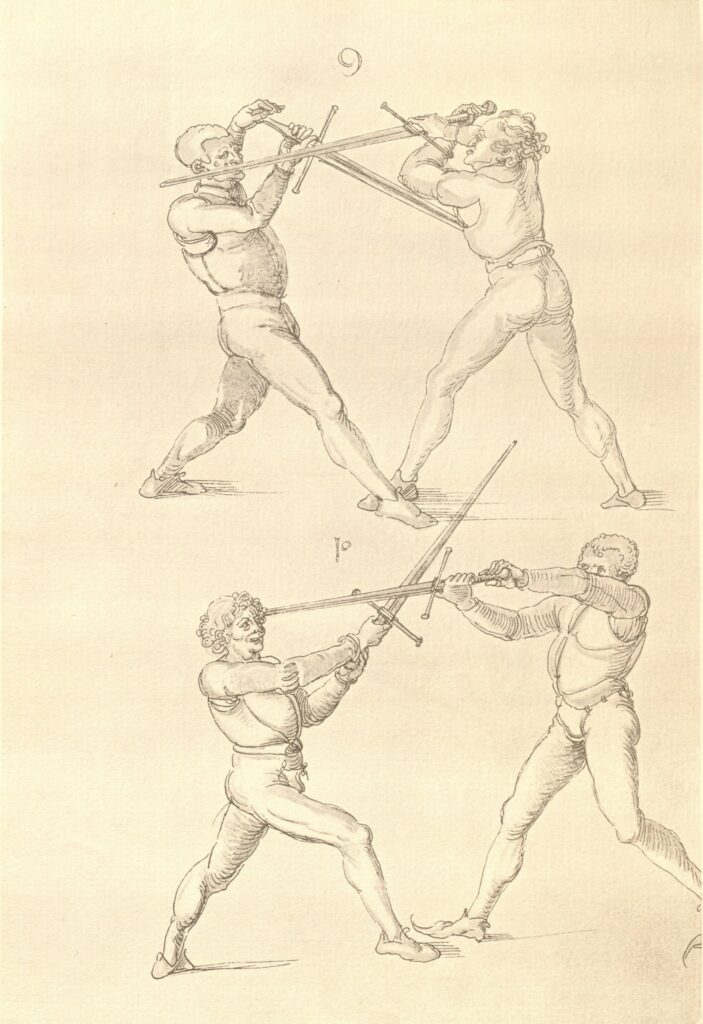

Who knew that Albrecht Dürer wrote—and illustrated!—his own fencing manual? I ordered a copy of Dürer’s Fight Book: The Genius of the German Renaissance and His Combat Treatise.
It predates Meyer, and covers wrestling, dagger, longsword, and messer.

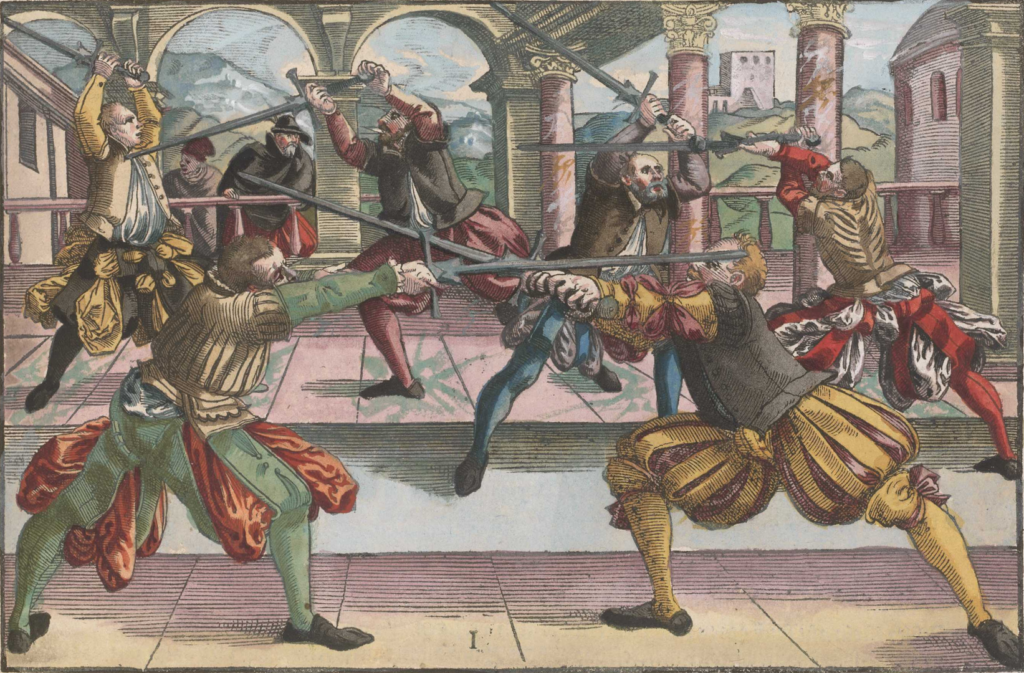
A couple of aspects of longsword turn out to be hard not from a skill perspective, but from a simple strength and endurance perspective. Look at the guys in this picture. Their arms are fully extended, either forward or upward. That’s just hard to do for minutes at a time. Besides that, they’re in a pretty low lunge position. That’s also hard to do for minutes at a time.
A couple of days ago, I had a chance to ask celebrity trainer Mark Wildman how he’d program for building arm strength and endurance. It turns out he’s a huge longsword geek. Here’s the video, cued up to where he reads my question (should be 41:57). The related stuff goes through 48:50).
My original question was: “I’m doing longsword. One issue is arm strength and endurance. I’m doing kettlebell clean&press and pushups (for holding the sword overhead and extended forward). Any other ideas?”
Here are my notes on Mark’s reply:
Mace & Club
Single-arm heavy club program (a program that isn’t for sale yet, but that is pretty easy to deduce from the videos on Mark Wildman’s youtube channel).
Basis of Strength (2-Handed club program that does exist, although it’s pretty expensive).
Mace 360s. (The mace equivalent of a club shield cast: You bring your hand past your opposite ear, swing the mace behind you, and catch it back in front.)
Cut the Meyer square for time. (I don’t think he said WHAT time would be appropriate. Maybe do a 10-minute emom, where you do the full square, rest until the end of the minute, and then repeat. Or maybe 30 seconds on/30 seconds off.)

He emphasized training both dominant hand and non-dominant hand.
This, by the way, goes against the advice of Liechtenauer, who says:
Fence not from left when you are right. If with your left is how you fight, You'll fence much weaker from the right.
I suspect that the difference has to do with your goals. Liechtenauer was speaking to someone who had to win sword fights. Wildman is speaking to someone trying to get fit for a hobby.
Push ups as part of a warm-up. (Since I had mentioned pushups.)
Instead of pushups, do burpies in full HEMA gear. (Oy.)
Don’t do actual sword movements with mace or club. Do those with an actual longsword.
Mace drop swing in Meyer stance (4 versions: contra- and ipso- lateral with each foot forward): Here’s two videos of that:
I’ve ordered a mace so I can try that (and other mace stuff). I haven’t yet pulled the trigger on the (expensive) Basis of Strength program, although I’m tempted. While I ponder that, I’ll start doing mace drop swings while in a lunge, and see if I can get both my extended arm strength and endurance up, while also improving my Meyer fencing stance.
My copy of the new translation of Meyer’s 1570 sword-fighting treatise has arrived!
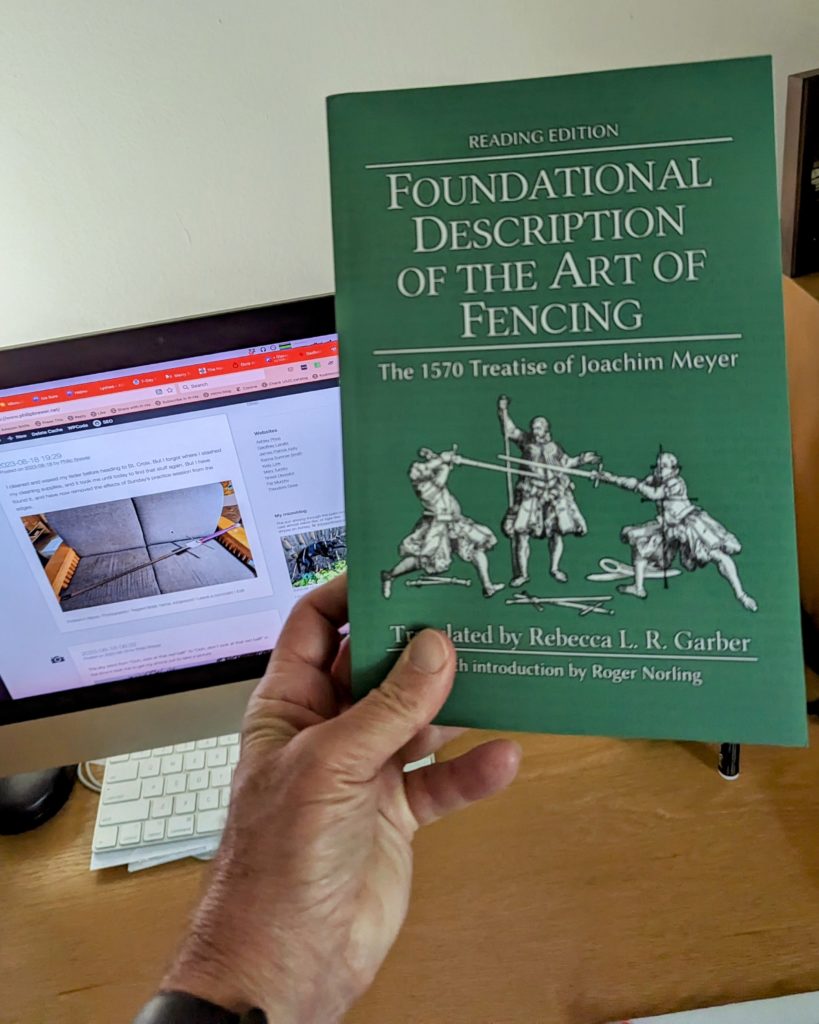
In my workout yesterday, in the “lower body” slot where I’d usually do either some type of squat or some type of lunge, I decided to practice stepping for longsword fencing. As soon as I started, I realized there was all sorts of nuance to how to do it, with a lot of details I wasn’t sure of.
I posted a question to the group discord, asking when to pivot the foot. (That is, the front foot is pointed straight ahead and the back foot is turned out 45 to 90 degrees. After you step forward with your back foot it’s easy enough to just put it down pointed straight ahead. But your new back foot needs to turn out at some point.) I also wanted to know whether people did a toe-pivot or a heel-pivot.
A couple of people responded to say that they did toe-pivots, and that they did them at the end, after establishing the new front foot. Good to know.
When I got to today’s class, Christopher Lee French (one of the intermediate HEMA students, but also an instructor in sport fencing at The Point Fencing Club & School of Champaign) gave me a whole master-class in stepping. He made a series of excellent points.
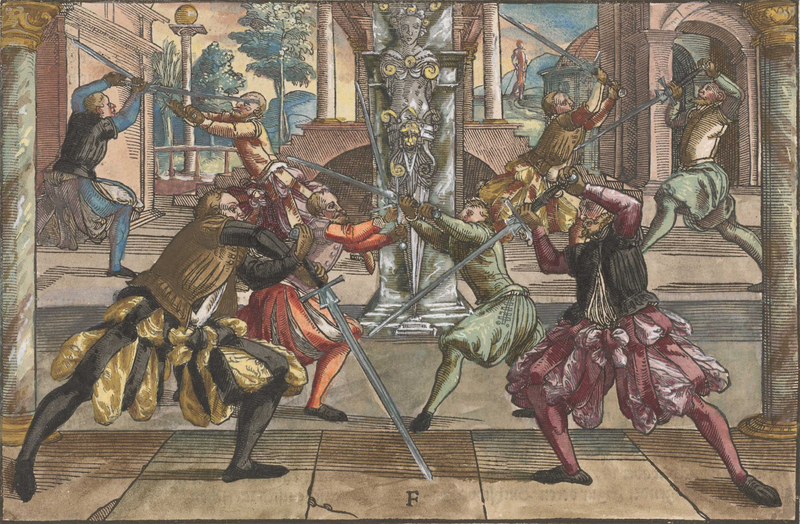
(Let me pause just for a moment here to make it clear that all the following is my understanding informed by what he was telling me. It’s certainly not his fault if I’ve gotten some things wrong here.)
Here’s a short list:
He demonstrated many of these, and his example steps also helped me make sense of the (to me) odd use of a toe-pivot described by others in the discord. He tended to finish a quick step with his back foot not yet pointed out. Instead it was pointed forward, with the heel off the ground. When I asked about why he wasn’t turning it out, he said, “Fix that when you have time.” And the way you’d fix it would be to do a toe pivot, and then put your heel down.
None of this really has much to do with Meyer’s text. That is, I’m not trying to figure out how to step. Rather, I’m thinking about what to train to be able to execute what Meyer’s text documents.
Specificity would suggest that the way to train for fast, smooth, even steps would be a lot of stepping. But I know from experience that it’s always worth breaking these things down and checking to see if any of the pieces is posing a limitation.
To pick a not-so-random example, I’m limited by my leg strength for single-leg standing in a very low stance. Things to train for leg strength with bent knees: wall sits, single-leg wall sits, single-leg standing. Those first two I’ve done before, but I can emphasize them a bit for a while. I can add some bent-knee single-leg standing. And, because specificity is still a thing, I’ll also practice executing passing steps and gathering steps as smoothly and rapidly as possible.
I’ve long known I’m no good at paying attention to more than one thing at a time. Because of that, I try pretty hard to avoid even trying to multitask. Still, even having accepted that I’m crappy at this sort of thing, I’m a little frustrated at how it’s showing up in my longsword practice.
Generally I think I’m okay if I try to just do one thing. For example, I’d assume I could execute a single cut or a single parry. But, no. In fact, I can only do a piece of a cut or parry—because one of the things Meyer says is “Every cut gets its step.” So I’m not doing it right unless I do the sword action and the stepping action.
It’s not actually quite as bad as I’m making it sound. I can move into any of the guards. I can swing my sword in any of the principle cuts. I can step with proper form. I can even swing my sword and step forward. But as soon as I try to, let’s say, step to the side and swing my sword, my form tends to break down.
Longsword is called “longsword,” not because the sword is long, but rather because nearly all the cuts and parries are executed with the arms extended. (And this is actually crucial to being successful. If you have your arms extended and your body in the right position, you can parry any cut. Try that with your elbows bent, and you’re very likely to get hit with a sword.)
I can hold the sword in good structure, with my arms straight. I can execute a cut with it, with my arms straight. I can even execute a cut and step forward, with my arms straight. But when I try to do any specific cut with any specific footwork, my form starts to break down: I tend to pull my arms in. And if I focus on keeping my arms extended, I forget to take the step.
It’s very frustrating.
Fortunately, having learned taiji, I know the solution to this: Practice.
That is, proper “deliberate practice” à la K. Anders Ericsson, where you: perform an action, monitor your performance, evaluate your success, try to figure out how to do it better, and then repeat.
If I can only pay attention to one thing at a time, I need to break these sword moves down further. I need to practice keeping my arms straight during a cut, and then repeat that move (paying attention) over and over again, until I can do it without paying attention. Then I can add in the stepping, and practice cutting with a step over and over again until I can do both of those things without paying attention. Then I can start working on a longer phrase: cut while stepping, next cut while stepping. And so on.
I haven’t started practicing outside of class much yet. There are only certain things that can be done without a partner, but those things—stance, guards, footwork—are exactly what I need to practice.
And we will still be meeting over the summer, so I’ll have plenty of opportunity to practice the other things as well.
It’s time to make a plan.
In class a couple of nights ago the lesson was for us to take our first stab at understanding a piece of the text from Joachim Meyer’s The Art of Combat.
I’ve ordered a copy of the book. It hasn’t arrived yet (being shipped from England), but here’s a different translation of the same text from the Wiktenauer site:
Slicing
Is a fundamental element of proper handwork, when you rush from your opponent with quick and agile blows, you can block and impede him better with no other move than with the slice, which you, though you will treasure it in all instances as special as here, will hold in reserve. You must however complete the slices thus: after you entangle your opponent’s sword with the bind, you shall strive thereon, feel if he would withdraw or flow off from the bind, as soon as he flows off, drive against him with the long edge on his arm, thrust the strong or quillons from you in the effort, let fly, and as he himself seeks to retrieve, strike then to the next opening.
https://wiktenauer.com/wiki/Joachim_Meyer, “Of Displacing,” Slicing
The text we used translated what is here as “flow off” as “strike around,” which is actually a specific move (striking first to one side and then to the other). The translation included the word “pursue,” I think where this one says “drive against.”
I generally think of myself as being pretty good at working with text, but I found this remarkably difficult.
The correct move, the instructor indicated, was that you should not wait for the “flow around” or “strike around” to proceed, but rather “as soon as” he begins the move, “drive against” or “pursue” by thrusting your sword forward so that the guard of your sword is pressed up against his.
Since you caught him early in striking around, this leaves him in a very awkward position, giving you many options for striking him effectively.
This all makes sense, but I did not get it from my first ten readings of the text. Clearly I’m going to have to spend a lot of time and effort making sense of it, if I’m going to get good at this.
In our practice session, we did not have the picture:
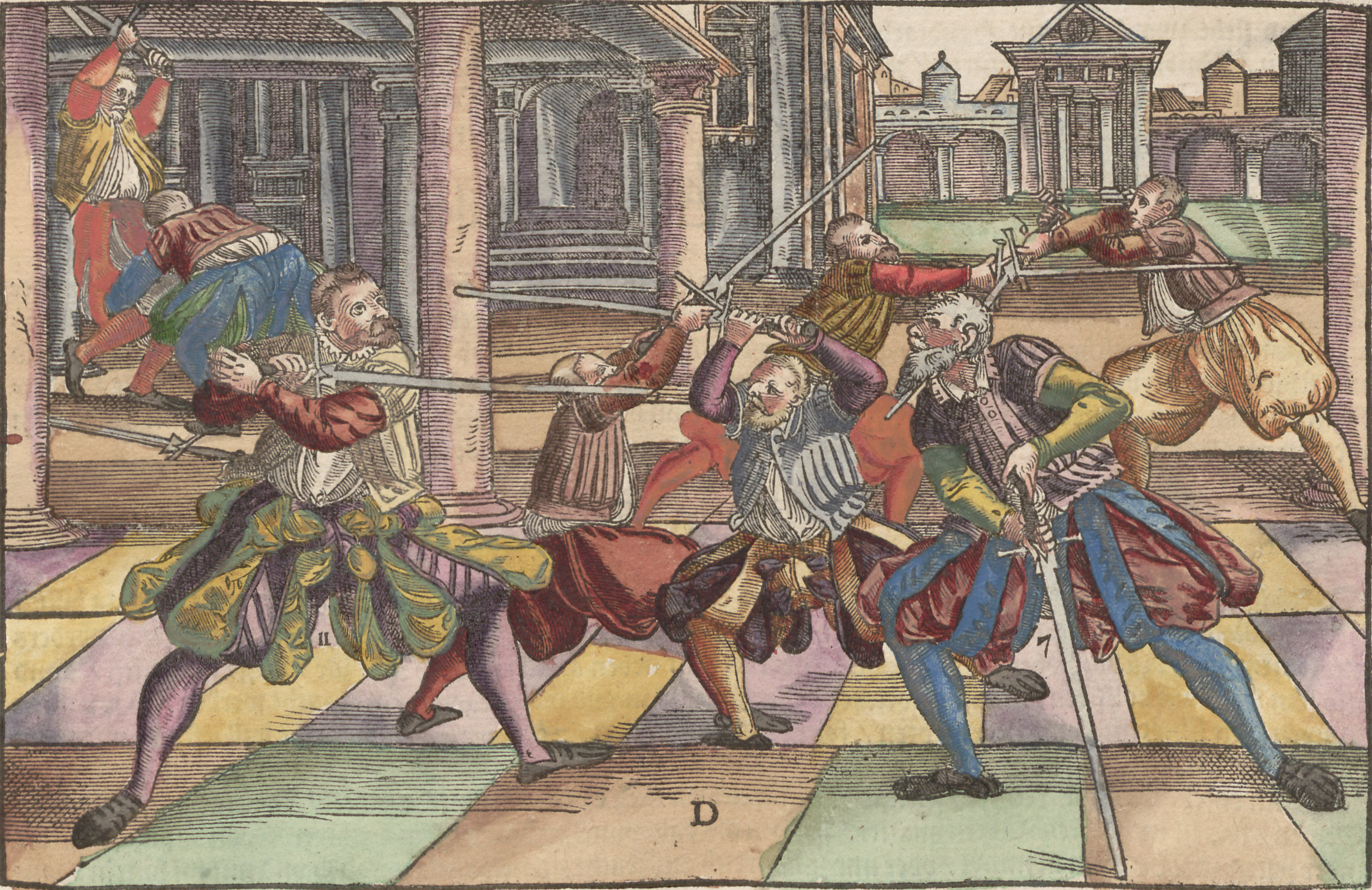
I think I see this move in the middle bit, where the guards of the swords are pressed together.
The most obvious goal for someone learning to fight with swords is to get good enough to enter sword-fighting competitions and do well against other sword-fighters. And, I suppose that is my long-term plan. My medium-term plan is less ambitious, but rather specific.
I’ve come up with this intermediate goal because I know that I am not a natural martial artist. My reflexes and hand-to-eye coordination are merely average. Besides that, I am well below average in my ability to watch someone execute a move and then do “the same thing.” I’ve written about this before in my post Learning movement through words.
I hadn’t realized it in advance, but the very nature of Historical European Martial Arts makes it especially well-suited to me: Essentially every HEMA practice is based on a text—in our case Joachim Meyer’s The Art of Combat. The text provides the verbal description that I need to be able to learn a movement practice.
Still, even with the text and the instructors showing us stuff (and correcting our errors) and classmates to practice with, I’m still the guy with merely average reflexes and hand-to-eye coordination (plus a lifetime of no experience with stuff like this, because I was in my 40s before I figured out that I could learn this stuff at all, as long as I have a verbal description to work from), so my expectations for developing the skills of an excellent sword-fighter are rather low.
That would be rather discouraging, so I’ve come up with my own personal medium-term goal. I’m going to focus on executing Meyer’s system very, very well. Success for me will not depend on doing well sparring with opponents, but rather on looking like—moving like—someone who has trained with the best teachers of Meyer’s system.
Expressed in aspirational terms: A year or two from now a modern expert in Meyer longsword will look at me and think, “Wow—this guy looks like he might have trained with Meyer himself!”
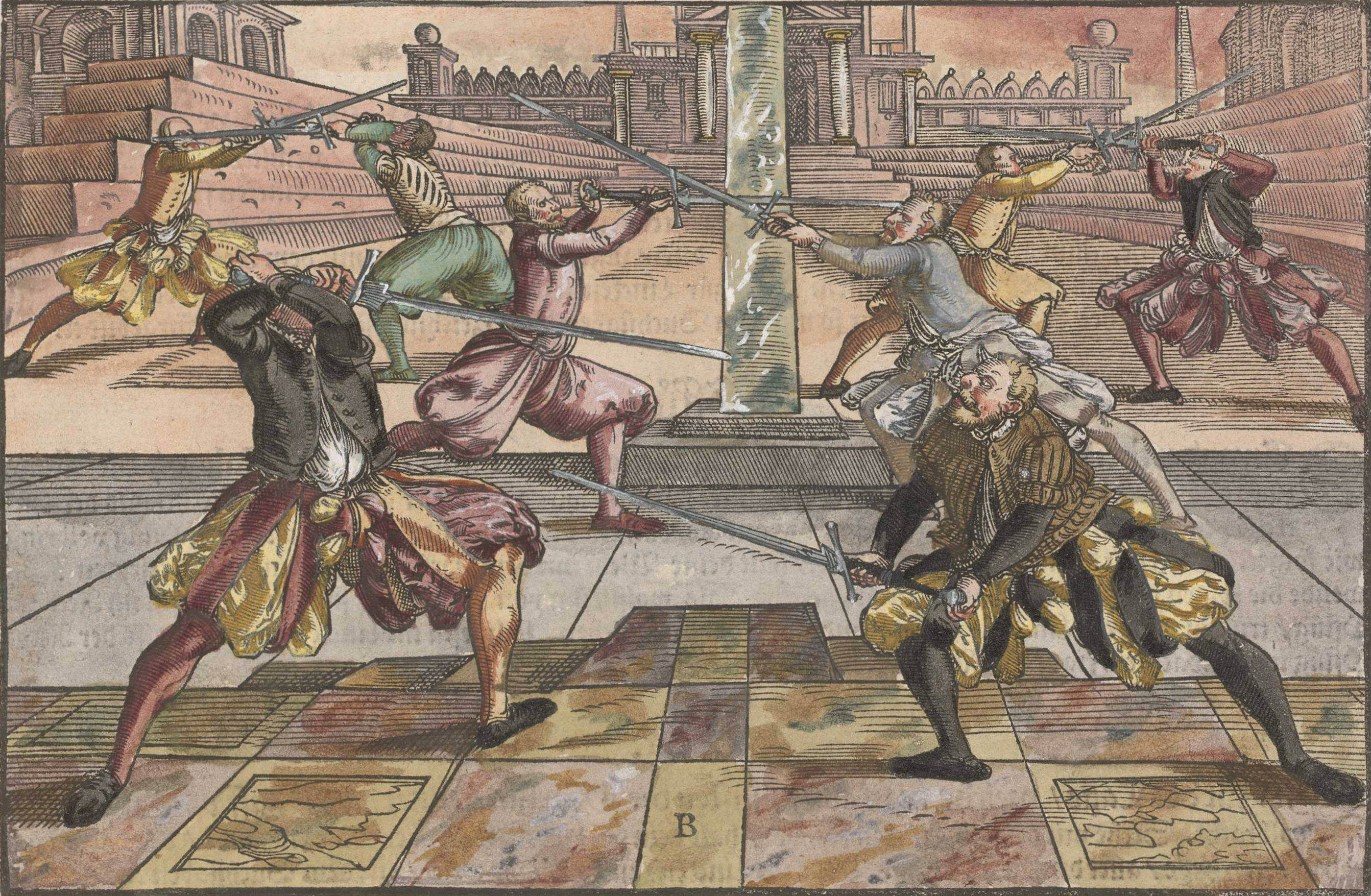
Knowing my own strengths and weakness, this seems like it might be achievable, with the bonus that it will probably be much more effective at making be a better sword-fighter than if I jumped right into trying to figure out how to spar well.
I had been waiting to get the new translation of Meyer that’s coming later this month from HEMA Bookshelf, but decided to go ahead and order a copy of the existing translation. It’s what everyone in the group has been working with for several years now, so the instructors and senior students all know it. I’m sure it’ll remain a useful reference even if everyone switches to the new translation as soon as it’s available. (And I’ll get the new translation immediately myself.)
My short-term plan to support my medium-term plan will be to create my own practice sessions on the foundational stuff: stance, footwork, guards, and cuts. The classes covered stance and footwork on the first day (and then added a third stepping pattern on the second day), but hasn’t returned to those things since then. This makes sense: We’re practicing stance and stepping as we’re learning cuts and parries. But for my purposes, I think and extra 15 or 20 minutes each day specifically working on these items (which are readily amenable to solo practice) will do me a world of good. I’ll also spend a few minutes each day working on the German vocabulary, so I know the names of everything (and know what the thing is!).
One bright spot: I seem to be fit enough. The first week and a half I was just a bit worried about whether I could do a 2-hour training sessions and the recover enough to do the next one and then the one after that, but it seems that my fitness regimen of the past few years is standing me in good stead. I may not be as strong or as fast (or recover as well) as the fitter of the college-age kids, but I’m fit enough to see a practice session through to the end.
This week I attended my first and second HEMA classes, and had great fun. I am even (almost) in good enough shape to work out for two hours, although I’m certainly feeling it this morning.
The first class was half devoted to longsword fencing at a conceptual level, looking at key concepts from Joachim Meyer’s The Art of Combat (which serves as the basic text for the local HEMA group), with the second half devoted to stance and footwork.
The concepts section had to do with the “five words” of Meyer: Vor (= before), Nach (= after), Sterk (= strong), Schwach (= weak), and Indes (= during, or maybe between). Quite a bit of time was spent talking about these concepts, which nevertheless remained subtle and (at least to me) rather unclear.
The stance was kind of interesting, purely because of the modest difference between a longsword stance and santi stance.
In Tai Chi, santi stance is described as a spiral: Your back foot is turned out about 45 degrees, your front foot is turned in (that is, the same direction as your back foot) just slightly. Your hips are turned less, kind of between your feet. Your torso turned less. Your shoulders are turned still less, your head is turned only slightly. Perhaps only your forward eye is pointed directly at your “partner” (i.e opponent).
Meyer’s longsword stance is different: Your back foot is still turned out 45 degrees (or up to 90 degrees). But your front foot is pointed straight forward, as are your hips and shoulders.
Once we’d we practiced the stance (getting our front knee directly over our front ankle, making sure our back knee was modestly bent), we went on to footwork, learning the passing step and the gathering step. Passing step is just stepping forward, except of course, that changes which is the front foot (pointed forward) and which is the back foot (turned out). The gathering step is like an advance in fencing: you back foot steps up to about even with your front foot, and then your front foot moves forward to reestablish a proper stance. And, of course, you don’t need to be committed: You can move your back foot up, and then if circumstances warrant, simply put it back where it had been.
The second class began with a pretty extensive warmup. We did some mobility, and then some stretching, and then some practice stepping, which both got us practice and got our heart rates up a bit. Then—one part I had trouble with—a bunch of lunges: regular lunges, backward lunges, jumping lunges. (Click my “lunge” tag to read a bit more about my difficulties with lunges.) We also sprinted just a little, I assume primarily to get our heart rates up.
Then we learned one new step: Triangle step. In triangle step you bring your back foot behind the front foot, taking you off-line from an attack from the front.
We practiced something they called “dancing,” which is a variation on the introductory practice of push hands: you and a partner touch your hands together (finger tips, or fist) and then one leads, stepping forward or back, while the other attempts to remain stuck, by stepping back or forward, so as to remain at the same distance—while, of course, using proper Meyer longsword footwork.
After that we picked up swords for the first time!
We learned the four principal guards, and then four cuts. They all had names, but unfortunately the acoustics weren’t good enough for me to hear most of them. But there are extensive web resources (including translations of Meyer’s book), so I have the technology to track them down and learn them before Tuesday.
We practiced the guards and cuts quite a bit, which (after all the stepping practice) left me pretty tired, and rather achy this morning. Happily, I’m not suffering from any over-use injuries, just feeling like I got in a good workout. (The one exception is my toes, which were slightly strained from the lunges. Hopefully they’ll be all better very shortly. Henceforth I’ll remember to do some toe stretches before each the HEMA class.)
The steel club swinging I’ve been practicing for months now stood me in good stead: my hands, wrists, arms, and shoulders are strong enough and stable enough, which I don’t think they would have been otherwise.
Classes take place in the Stock Pavilion, an old University of Illinois building (constructed over 100 years ago) originally built to support the Ag school’s mission as a place for students to learn about things like cattle judging. It’s a large space with a dirt (wood chip) floor and concrete bleachers, which suits pretty well for sword-fighting practice.
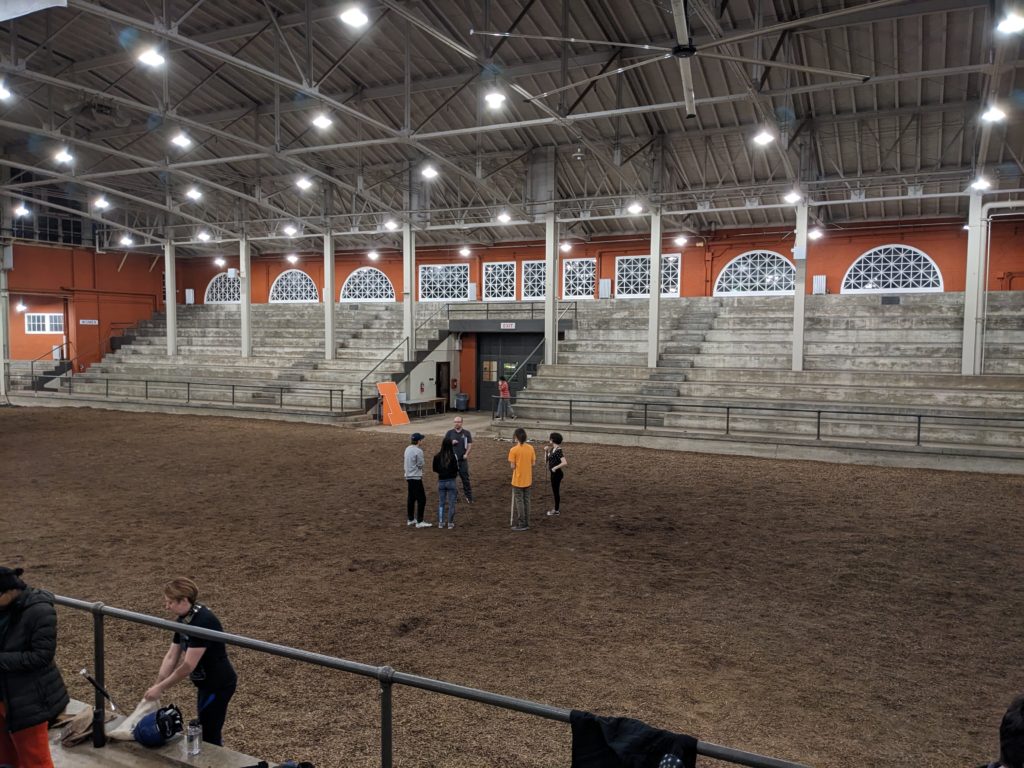
Next thing to do: buy protective gear (mask and gloves). I’ll also want to get a copy of The Art of Combat, which I understand has a new translation coming out next month, so maybe I’ll wait for that.